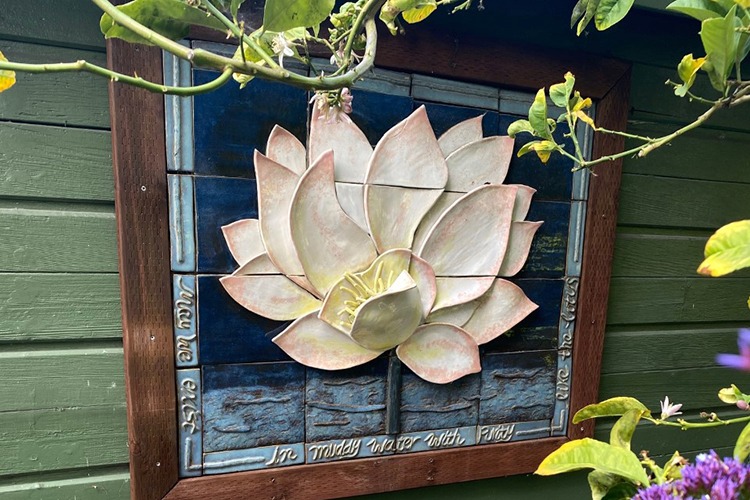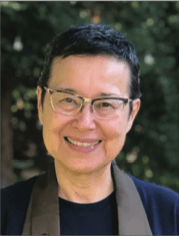
How to Grow a Lotus Blossom
April 1, 2021
 by Wendy Egyoku Nakao
by Wendy Egyoku Nakao
A monk asked Chimon, “What is it when the lotus has not yet come out of the water?”
Chimon said, “Lotus flowers.”
The monk asked, “What is it after the lotus has come out of the water?” Chimon replied, “Lotus leaves.”
—Blue Cliff Record, Case 21
In this second year of the Covid-19 Pandemic, we are plunging into the Lotus Sutra, a renowned Mahayana text. Composed over a span of a hundred years, about seven to eight hundred years after the parinirvana of Shakyamuni Buddha, the Lotus Sutra contains many shocking revelations which we now consider staples of the Mahayana path. An important revelation is the path of the bodhisattva as the main path of practice— specifically, its inclusivity, that everyone, without exception, can realize Buddhahood. Extending this further, you and I, in the midst of our lives now, can take up the vow to make it happen. In the midst of this Pandemic, let us view this time as a Buddha field.
The Lotus Sutra itself is considered as the body of the Buddha. Regarding a sutra as the very body of a Buddha is not uncommon in the Mahayana tradition. Even so, the Lotus Sutra is afforded a particular kind of reverence. For example, when we chant the Names of the Buddha during meals, closing ceremonies, or even funeral services, we find Saddharma Pundarika Sutra among the Buddha’s names. This is the name of the Lotus Sutra in Sanskrit. Hence, the Lotus Sutra is regarded as a name of the Buddha. The title itself is also regarded as encapsulating the entire Sutra.
“What is it when the lotus has not yet come out of the water?”
The Japanese title of the Lotus Sutra is Myo Ho Ren Ge Kyo—The Wonderful (Myo) Dharma (Ho) Lotus (Ren) Blossom (Ge) Sutra (Kyo). This title is chanted as a mantra by the Nichiren Buddhist sect— “Namo-Myoho-Renge-Kyo.” In the mantra, the word namo is the same word as in Namo ki e Butsu, or “Be one with Buddha.” Namo or “Be One” means “Plunge!” Plunge into Buddha— enter completely into Buddha! You and I enter the Wonderful Dharma of the Lotus Blossom Sutra completely. This supreme Sutra is worthy of you; you are worthy of it. Why? Because you are it. Let’s take a look at what we are by examining the title itself.
Myo-Ho means “wonderful dharma.” What is a wonderful dharma? It is that which defines reality. In other words, it is everything—all forms, all phenomena, all manifestations of life. Although you yourself may consider certain dharmas (as defined above) as wonderful and other dharmas as not wonderful, this sutra tells us that everything, without exception—including every person without exception, is a wonderful dharma. The dictionary definition of the word “wonderful” is “inspiring delight, pleasure, or admiration; extremely good; marvelous.” This can easily lead us to eliminating all that this definition does not apply to in our opinion, such as unethical people, cruel people, or people with radically different views that we find offensive to our own. Such persons are not wonderful to us from a conventional or personal viewpoint. They are, however, in essence “wonderful” because each is thoroughly penetrated through by its essence. Myo-Ho points to the fact that a dharma—any and all dharmas—is wonderful because it is precisely essence in its being. Why is such a view useful to us? Because this fact pierces us with a big view—it speaks to the possibility and potential of fulfilling Buddhahood.
You yourself are a wonderful dharma. Realize the thoroughness, the completeness, of your being—the Thus- ness of your being—just as it is, prior to being distracted by your thoughts— your opinions, judgements, likes and dislikes—about yourself. Know yourself as that which is already pierced through by Buddhahood, as the one whose Buddhahood is predicted in the Lotus Sutra. Although this may seem a remote possibility to you, or at least one that creates great doubt, know that you are already included in Buddhahood. It is like the monk in the koan who asked Chimon, “What is it when the lotus has not yet come out of the water?” Chimon replies, “Lotus flowers.” Already thus; already whole and complete!
This very fact of your completion as the foundation of your being also reflects other aspects of myoho. The great teacher Nichiren says that myo has three meanings. First, to open. Specifically that the Lotus Sutra opens up the meaning of all other sutras. For our purposes, we open up ourselves and our lives as the meaning of the Sutra. Second, perfectly encompassing. Each word of the Sutra encompasses all the other words within itself. That is true of ourselves—each of us encompasses all other beings within ourself; we are encompassed by all other beings as well. And third, to restore life. The reference for the Sutra is that by reciting and practicing the Lotus Sutra, the seeds and causes of buddhahood are restored in those who have neglected them. For us, it raises awareness of the importance of our effort to nurture the Bodhi Mind.
What is the totality of you?
Ren-Ge means lotus blossom and its usage here refers to bodhisattvas—as a bodhisattva, you are like a lotus plant. The lotus plant, which dates back to 5,000 BC, was esteemed in ancient Egypt and China and continues to flourish throughout Asia even today. In Los Angeles, Echo Park lake has a section of lotus flowers, which bloom in the summer. According to the website Leading Lotus, the lotus plant’s “survival has been attributed to its powerful genetic system that allows it to self-revive and regenerate. Scientists in 1990 were able to re-germinate a 1,300 (+/- 270) years old seed back to life, after laying dormant. That is equivalent to reviving a frozen caveman.” Due to its remarkable characteristics, such as its genetics, rooting in mud, and stalks that emerge five feet from the water to bloom as a spectacular flower high above the surface of muddy water, the lotus flower has symbolized spiritual journeys for centuries.
The lotus plant develops a complex and deep root system in the murkiest mud and muck, roots vast enough to sustain the emergence of a stalk with large leaves resting on the surface of muddy water and a flower three to five feet above the water’s surface. The Venerable Thich Nhat Hanh wrote, “The Lotus grows out of the mud. Without the mud, there is no Lotus. Suffering is a kind of mud, that we must use in order to grow the flower of Understanding and Love.” The mud is the hard stuff in our lives, and it’s in rooting in the muck that we find the nutrients—the resources and strength—that are the hallmark of spiritual growth, of becoming a Buddha. The Buddha seed grows continuously in the muck because you have an innate capacity to seek out the very nutrients that enable you to grow.
Upon reflecting on mud, I am reminded of a libation ritual of reconciliation that I witnessed recently. Soil had been collected from the spot where Mr. Lee Snell, a Black man, had been lynched in Florida. As part of the program, water in elegant stemmed glasses was poured into the soil in a ritual act of libation. At that moment, I felt my own ungloved hands turning the wet soil, making mud, stirring the essential nutrients to encourage something to grow from the spot of such an inhumane act of racial violence. So, too, for you—the buddha seed takes root in the mud of your life. You are of mud and, at the same time, you are not defined by it. As Shakyamuni Buddha said, “As a lotus flower is born in water, grows in water and rises out of water to stand above it unsoiled, so I, born in the world, raised in the world having overcome the world, live unsoiled by the world.” This interesting quotation reflects an early teaching. From the viewpoint of the primordial or eternal Buddha of the Lotus Sutra, this might be rephrased to read, “As a lotus flower is born in mud, grows in mud and rises out of muddy water unsoiled, so I, born in the world, having drunk deep of the nutrients of suffering, have realized buddha essence and act to help everyone to awaken.”
Root deeply and let yourself bloom! Buddhahood is guaranteed.
In the koan above, the monk next asked, “What is it after the lotus has come out of the water?” Chimon replied, “Lotus leaves.” Leaving aside for a moment the thrust of this koan, let’s further appreciate this complex lotus plant. The leaves, which can be as large as 2 feet in diameter, are ultrahydrophobic. Water gathers dirt from the leaves and rolls off the plant. The stalk and flower rises unstained by the mud in which it roots. When the lotus flower emerges, its pod already has the seeds, which, when it is time, will fall back into the pond. At night, the flower closes and sinks back into the water—the warmth of the flower petals preserves heat so any insects inside of it will have warmth for the night. As the sun rises, the flower re-emerges above the water. What amazing resiliency! You have this resiliency, too.
Under the water, out of the water—how about it? The aspects of before and after are obvious to us, but Zen wisdom always asks more of us—it demands that you go both deep and broad. You can make distinctions without losing sight of the one body, the completeness of being. Yamada Roshi says that this koan is similar to the koan “What was your face before your parents were born?” What is the totality of you?
This leads us to the last word of the title, Kyo. Kyo means sutra. In English, the word means thread, that which pierces through all layers and phases of life—that which stitches life all together. You may think that your notions of my-me-mine stitch together your perception of who you are and your life itself, but the The Lotus Sutra and Master Chimon tells you otherwise. What is the thread that stitches your life together with all other lives? What is the thread that you are constantly pulling through all the circumstances of your life? I read that there is a way to make threads from the lotus stem—the wonders of this plant never ceases to amaze. You are amazing, too. The murky mud is rich, nutrient-dense, and just the right temperature for growth. Root deeply and let yourself bloom! Buddhahood is guaranteed.
Roshi Egyoku is ZCLA’s Head Teacher and Abbot Emeritus.
